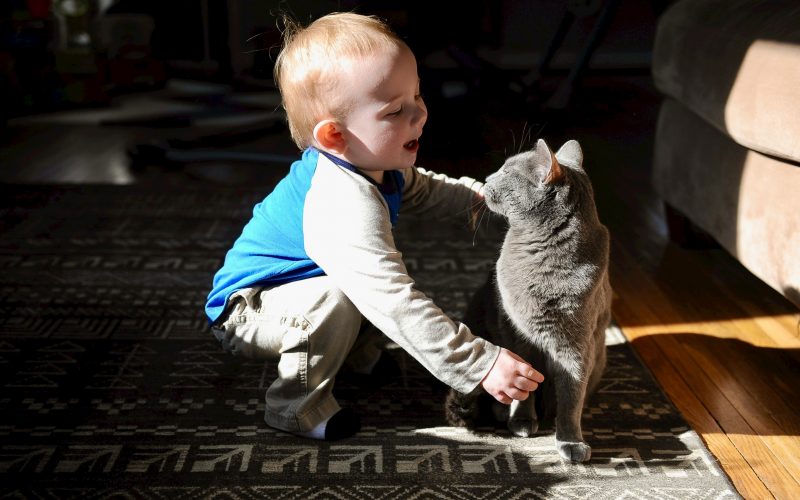Does your child have a cat allergy but loves cats? Or, perhaps your child has friends or family who have cats, creating an issue when your child is around them. Either way, navigating the intricacies of a cat allergy can be challenging.
Luckily, allergy immunotherapy is a promising solution that helps reduce your child’s sensitivity to the allergy through repeated exposure. It targets the allergy, not the symptoms. In this blog, we’ll explore cat allergies, allergy immunotherapy, and how the latter can help tackle the former to promote your child’s quality of life.
Cat Allergies: The Basics
Cat allergies are much like any other allergy – they’re the immune system’s reaction to a foreign substance, which, in this case, is the cat. When your child is allergic to something, their antibodies, blood proteins responsible for counteracting a specific antigen, flag the substance as harmful, even if it isn’t.
For example, suppose your child is allergic to cat dander. When their body comes into contact with the substance, those antibodies react, triggering a response by communicating with cells that release specific chemicals. Their symptoms can range from a runny nose to difficulty breathing, depending on the severity of the allergy.
The Root Cause of Cat Allergies
While many people believe pet fur is the culprit behind pesky allergies, this isn’t always the case. For most folks, the allergy stems from the cat’s dander, which are dead skin cells the animal sloughs off to make room for new ones.
Dander can hang out in the air for long periods and cling to various surfaces, causing flare-ups even when the cat isn’t around.
Additionally, cat saliva can cause similar effects. It, too, can remain airborne when dry and cling to various surfaces, triggering allergic reactions long after the cat has left the area.
What is Allergy Immunotherapy?
Allergy immunotherapy is a treatment approach designed to reduce the body’s sensitivity to a particular allergen, like cat dander, saliva, or fur. It works by exposing the body repeatedly to small, incrementally increasing doses of the allergen.
Over time, this exposure helps reduce the production of the “blocking” antibodies that create the reaction, resulting in an allergen-specific tolerance. Achieving such a result takes time, as your child’s body will need to adjust. However, most people notice results within the first year, although the best results often appear in years two and three.
Types of AIT
There are two primary types of allergy immunotherapy: sublingual and subcutaneous. Sublingual immunotherapy (SLIT) involves allergy drops or tablets that contain small amounts of the allergen administered under the tongue.
This method is often used for kids, as it doesn’t involve frequent doctor visits or regular injections. Parents can administer each dose at home, making it a convenient way to tackle pesky allergies.
Subcutaneous immunotherapy (SCIT), on the other hand, involves injections that contain doses of the allergen administered under the skin. This method, while highly effective, presents a higher risk of a reaction, so doctors usually administer it and monitor patients for a set period afterward.
Efficacy of AIT
Allergy immunotherapy might seem too good to be true, so do cat allergy shots actually work? Yes! Many studies have demonstrated the remarkable efficacy of allergy immunotherapy, showing its ability to help achieve an allergen-specific tolerance in people from all walks of life that remains beyond the discontinuation of the treatment!
Most studies evaluate allergy immunotherapy as a whole, but the efficacy is widely accepted and researched. If you want to learn more about this innovative treatment, there are plenty of clinical trials, research trials, and studies that can help!
Cat Allergy Immunotherapy for Kids
If your child is allergic to cats, cat allergy immunotherapy might be a viable solution. These treatments can be administered in various ways, but many parents choose the sublingual approach to skirt frequent doctor visits and injections.
Cat allergy shots for humans, not to be confused with feline vaccinations, are designed to minimize allergic sensitivity by harnessing the power of allergy immunotherapy. It helps address the root cause of your child’s allergy, decreasing sensitivity over time to help your child enjoy life free of allergic symptoms.
This is particularly handy for kids who love cats yet have an allergy. Of course, it’s important to note that every child is different, so the timelines for seeing results can vary. If you’re considering allergy immunotherapy for your child, talk to their allergist or primary care physician first. They can evaluate your child’s medical history and allergies to help you select the right solution for your child’s needs.
Wrapping Up
Navigating your child’s cat allergy can be tricky, especially if you’re a pet owner or have friends with pets, but allergy immunotherapy offers hope for long-term relief and improved quality of life. The treatment helps reduce your child’s sensitivity to cat allergens through repeated exposure, helping their immune system become more tolerant over time.
This approach can be an excellent fit for parents of children with cat allergies, but, as always, remember to check with your healthcare provider before beginning treatment.







